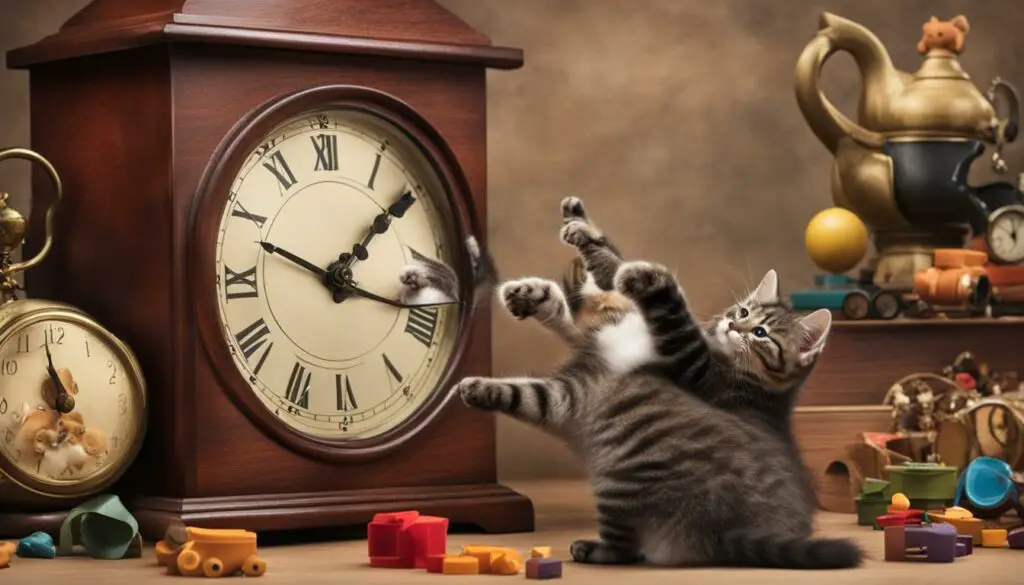A lot happens during a kitten’s first year of life, but when does a cat officially stop being a kitten? According to experts, cats are generally no longer considered kittens once they reach one year of age. This is when they enter adulthood and begin the process of maturing both physically and mentally. Let’s dive into the various stages of a cat’s growth to understand when they transition from being a kitten to an adult cat.
Key Takeaways:
- Cats are no longer considered kittens after reaching one year of age.
- Adulthood is marked by physical and mental maturation.
- Understanding a cat’s growth stages is crucial for providing appropriate care.
- Transition from kitten to adult is a gradual process lasting until around 18 months old.
- Cats continue to grow and develop until they reach their adult size and weight.
Kitten Stage: Birth to 6-7 Months Old
During the kitten stage, which begins at birth and lasts until around 6-7 months old, a cat undergoes significant physical and mental changes. This is a critical period for their growth and development.
Proper nutrition plays a vital role in supporting a kitten’s growth. Providing them with a balanced diet that meets their specific needs is essential. Choose high-quality kitten food that includes the necessary nutrients for their development. Consult with a veterinarian to ensure you’re feeding your kitten the right food in the appropriate amounts.
In addition to nutrition, socialization is key during the kitten stage. Expose your kitten to various experiences, environments, and people to help them become well-adjusted adult cats. Allow them to interact with other friendly animals and gently introduce them to different sounds, objects, and situations. This will help build their confidence and prevent behavioral issues in the future.
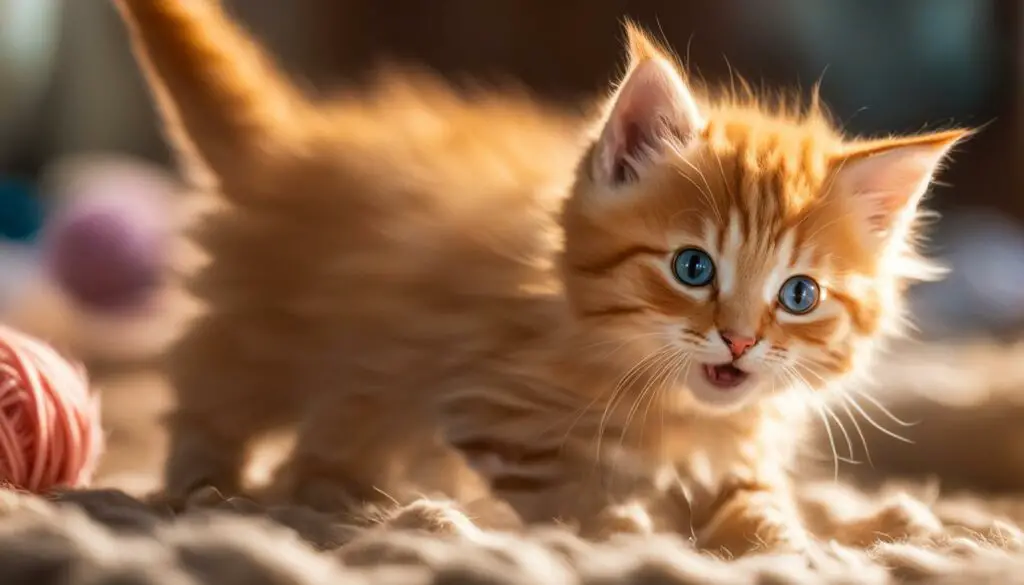
Introducing your kitten to the litterbox is also crucial during this stage. Place the litterbox in a quiet and accessible area and show them how to use it. Be patient and consistent with litter training, and praise them when they successfully use the litterbox. This will help establish good litterbox habits that will continue into their adult life.
| Key Points about the Kitten Stage: |
|---|
| 1. Kitten growth and development happen from birth to around 6-7 months old. |
| 2. Provide proper nutrition with high-quality kitten food. |
| 3. Socialize your kitten to different experiences and environments. |
| 4. Introduce the litterbox and encourage good litterbox habits. |
Ensuring your kitten’s well-being during the kitten stage sets the foundation for a healthy and happy adult cat. By providing them with the right nutrition, socialization, and litterbox training, you’re giving them the best start in life.
Junior Stage: 1-2 Years Old
During the junior stage, which typically lasts from 1 to 2 years old, cats have reached reproductive maturity but are still growing. This is an important phase in their development, as they transition from kittens to adult cats. It is crucial to address their specific needs during this time to ensure their well-being and happiness.
One of the key considerations during the junior stage is managing their reproductive maturity. Cats can become fertile and may exhibit behaviors such as wandering and spraying to mark their territory. To prevent unwanted behaviors and ensure the cat’s safety, it is recommended to spay or neuter them at this stage. This procedure not only helps control the cat population but also eliminates the risk of certain reproductive-related health issues.
In addition to addressing reproductive maturity, it is important to continue providing proper litterbox training and reinforcing good litterbox habits during the junior stage. This includes providing a clean and accessible litterbox, using the appropriate litter, and regularly cleaning the litterbox to maintain hygiene. Consistency and positive reinforcement are key to establishing good litterbox behavior.
Behavior, Activities, and Medical Needs
Junior cats are typically full of energy and curiosity, so it is essential to provide them with adequate mental and physical stimulation during this stage. Interactive play sessions, puzzle toys, and scratching posts can help keep them engaged and prevent boredom-related behaviors. Regular exercise through playtime and access to climbing structures or cat trees can also help satisfy their natural instincts and maintain their overall health.
During the junior stage, regular veterinary check-ups and vaccinations are crucial to monitor the cat’s health and ensure they receive any necessary medical treatments. Vaccinations help protect cats from common diseases, while routine examinations allow veterinarians to identify any potential health issues early on. It is also important to provide a balanced diet that meets their specific nutritional needs to support their growth and development.
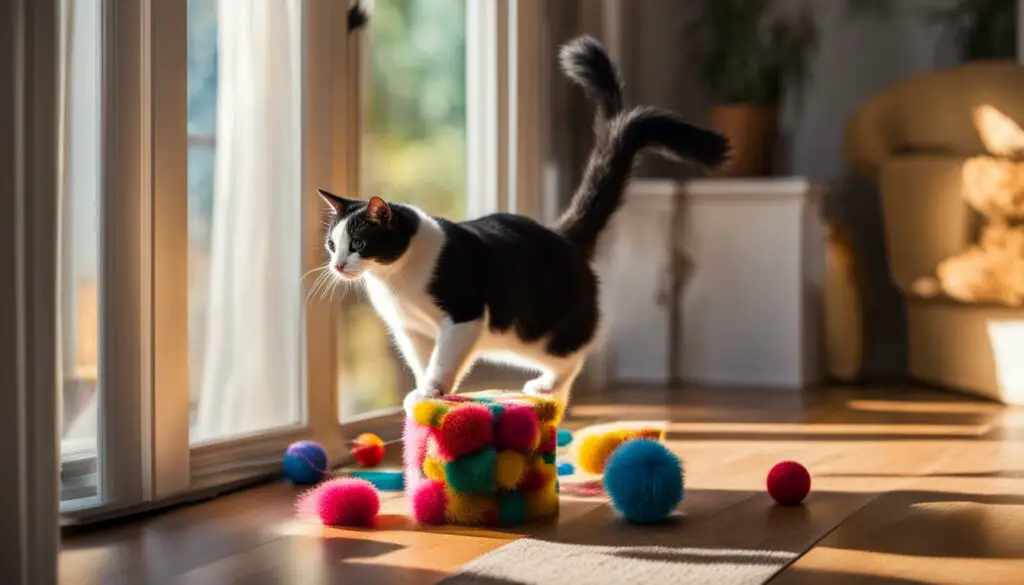
| Junior Stage: 1-2 Years Old | Considerations |
|---|---|
| Reproductive Maturity | Monitor and manage reproductive behaviors, consider spaying or neutering to prevent unwanted behaviors and health issues. |
| Litterbox Habits | Continue to reinforce good litterbox behavior through proper training, provide a clean and accessible litterbox. |
| Behavior and Activities | Provide mental and physical stimulation through play, interactive toys, and access to climbing structures. |
| Medical Needs | Regular veterinary check-ups, vaccinations, and a balanced diet to support growth and overall health. |
By addressing the unique needs of cats during the junior stage, we can help them transition into healthy and well-adjusted adult cats. Providing appropriate care, training, and medical attention during this phase sets the foundation for a lifetime of happiness and companionship.
Adult or Prime Stage: 3-6 Years Old
During the adult or prime stage, which lasts from 3 to 6 years old, cats have fully transitioned from kittens to mature adults. At this point, they have established their temperament and personality, and their behaviors have stabilized. Adult cats are generally more independent and require less supervision compared to kittens.
However, it is still essential to provide adult cats with regular exercise and mental stimulation to keep them healthy both physically and mentally. Engaging in playtime activities, such as interactive toys and puzzle feeders, can help keep adult cats mentally sharp and prevent boredom.
In addition to keeping them physically and mentally active, adult cats also benefit from regular veterinary visits. Yearly check-ups are crucial for monitoring their overall health, weight management, and dental hygiene. It is also a good opportunity to discuss any behavioral changes or concerns with the veterinarian.
Table: Adult Cat Behavior and Activities
| Behavior | Activity Level |
|---|---|
| Playfulness | Moderate |
| Sleeping | 12-16 hours per day |
| Grooming | Frequent self-grooming |
| Exploration | Curiosity in familiar environments |
| Hunting | Less frequent, may still engage in play-hunting behaviors |
| Interaction | Enjoy human companionship, may show affection |
Overall, the adult or prime stage is a time of stability and maturity for cats. They have reached their peak physical condition and have settled into their adult behaviors. By providing them with regular exercise, mental stimulation, and veterinary care, we can ensure that adult cats lead happy and healthy lives.
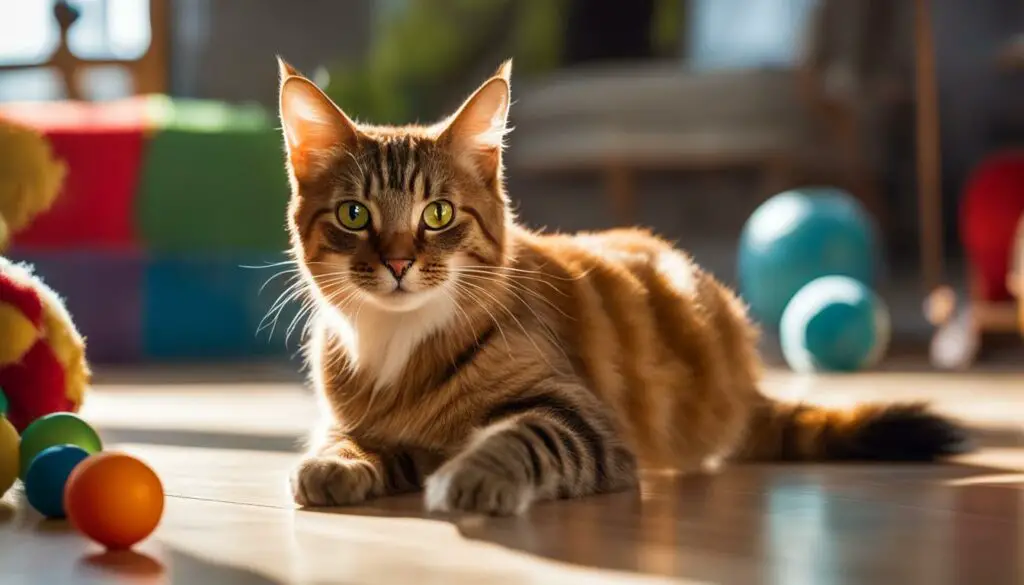
Mature Stage: 7-10 Years Old
During the mature stage, which occurs between 7-10 years old, cats experience a period of relative stability in terms of their physical and behavioral development. While they may not be as active as their younger counterparts, mature cats still require attention and care to ensure their well-being and quality of life.
One crucial aspect of caring for mature cats is addressing their specific medical needs. Regular veterinary exams become even more important during this stage to detect any age-related health issues such as arthritis, weight management concerns, or dental problems. These exams allow veterinarians to provide necessary treatments, recommend appropriate dietary adjustments, and manage any conditions that may arise.
The diet of mature cats should be tailored to their changing nutritional needs. It is essential to provide them with balanced meals that support their overall health and help maintain a healthy weight. Consultation with a veterinarian can help determine the best diet for a mature cat, taking into consideration their specific health requirements and any existing medical conditions.
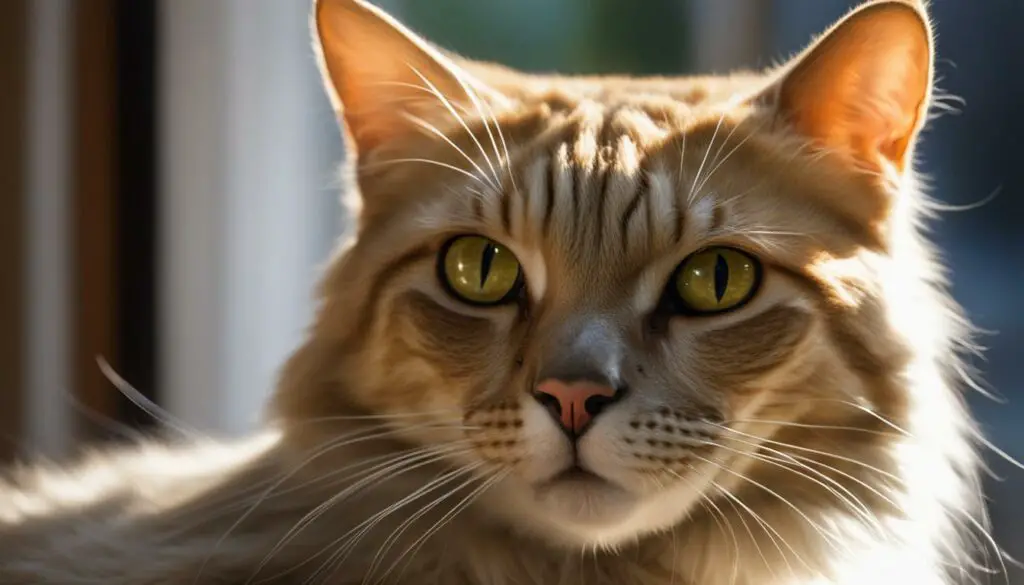
| Medical Needs | Diet | Activity |
|---|---|---|
| Regular veterinary exams to monitor overall health | Tailored diet to meet changing nutritional needs | Decreased activity compared to younger cats |
| Detection and management of age-related health issues | Balance of essential nutrients | Encouragement of regular exercise |
| Treatment of arthritis, weight management concerns, dental problems | Consultation with a veterinarian for dietary recommendations | Providing mental stimulation and playtime |
While mature cats may be less active, they still benefit from regular exercise and mental stimulation. Playtime and interactive toys can help keep them physically and mentally engaged. Encouraging gentle exercises such as short walks or climbing is also beneficial for maintaining their muscle tone and joint mobility.
To ensure the well-being of mature cats, it is important to provide a comfortable and enriching environment that meets their specific needs. This includes providing cozy bedding, easy access to litter boxes, and vertical spaces for climbing and perching. Regular social interaction and affection are also essential for their emotional well-being.
Senior Stage: 11-14 Years Old
Cats in the senior stage, which occurs between 11-14 years old, experience further changes. They may sleep more, eat less, and exhibit decreased activity levels. Regular veterinary visits, including lab work, become even more important during this stage to monitor their overall health and detect any age-related conditions. Dietary adjustments, such as lower calorie and lower fat foods, may be necessary to maintain their optimal health. Additionally, special considerations may be needed for mobility issues and changes in vision and hearing.
As cats enter their senior years, it’s important to pay close attention to their medical needs. Regular check-ups at the veterinarian are crucial to catch any potential health issues early on. Lab work may be recommended to monitor organ function and ensure that any age-related conditions are promptly addressed. These exams also provide an opportunity to discuss dietary adjustments that can support optimal health and weight management. Senior cats may require a lower calorie and lower fat diet to prevent weight gain and reduce the risk of obesity-related health problems.
In addition to medical care, senior cats may require special attention to ensure their comfort and well-being. Older cats may experience mobility issues, such as arthritis, which may require modifications to their living environment or the addition of ramps or steps to help them navigate more easily. Changes in vision and hearing are also common in senior cats, so providing a safe and quiet environment can help reduce stress and anxiety. It’s important to remember that each cat is unique, so individualized care and adjustments may be necessary based on their specific needs and conditions.
Senior Stage: 11-14 Years Old
- Sleeping more
- Eating less
- Decreased activity levels
- Regular veterinary visits and lab work to monitor health
- Dietary adjustments for optimal health and weight management
- Special considerations for mobility issues and changes in vision and hearing
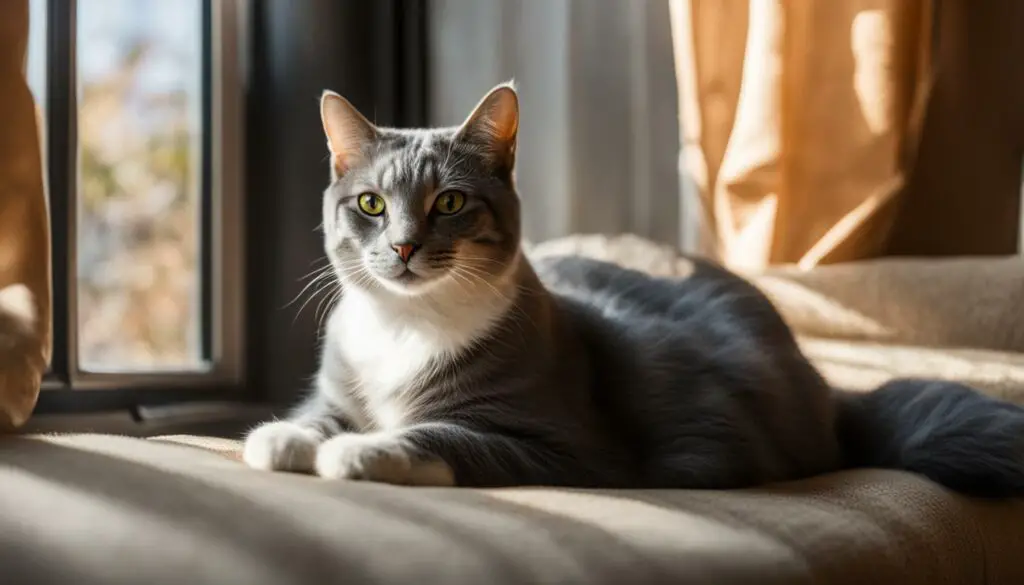
| Age | Characteristics | Recommendations |
|---|---|---|
| 11-14 years | Increased sleep | Provide a quiet and comfortable environment |
| Decreased appetite and activity levels | Monitor weight and adjust diet if necessary | |
| Potential mobility issues | Make modifications to the living environment for easier movement | |
| Changes in vision and hearing | Ensure a safe and quiet environment | |
| Regular veterinary visits and lab work | Detect and address age-related health conditions |
Geriatric Stage: 15 Years and Beyond
As cats reach the geriatric stage, which typically begins at 15 years and beyond, their medical needs become increasingly important. The aging process can bring about various health issues, making regular veterinary exams crucial. By scheduling exams twice a year, caregivers can closely monitor their cat’s overall health and detect any age-related conditions early on. These exams provide an opportunity to discuss any concerns with the veterinarian and ensure that the cat is receiving the appropriate care.
During this stage, it is essential to prioritize the comfort of geriatric cats. They may experience a decline in energy levels and require adjustments to their daily routine and environment. Creating a comfortable and safe space for them at home can help alleviate any physical discomfort they may be experiencing. It’s also important to keep in mind that geriatric cats may have difficulty with mobility, so providing easy access to food, water, and litter boxes can greatly improve their quality of life.
As cats enter the geriatric stage, their caregivers may face difficult decisions regarding their end-of-life care. It’s crucial to be prepared and informed about the available options, such as palliative care or euthanasia, to ensure that the cat’s well-being is always the top priority. Understanding and recognizing signs of suffering or decline in their quality of life can guide these difficult decisions. Caregivers should consult with their veterinarian for guidance and support during this emotional time.
| Veterinary Exams | Comfort | Difficult Decisions |
|---|---|---|
| Schedule exams twice a year to monitor health | Create a comfortable and safe environment | Be prepared for end-of-life care decisions |
| Discuss concerns with the veterinarian | Provide easy access to essentials | Consult with the veterinarian for guidance |
| Detect age-related conditions early | Alleviate any physical discomfort | Recognize signs of suffering or decline |
“The geriatric stage is a time that requires extra attention and care for our feline companions. Regular veterinary exams, creating a comfortable environment, and being prepared to make difficult decisions are all essential aspects of providing the best possible care for geriatric cats.”
Thoughtful Care for Geriatric Cats
- Schedule twice-yearly veterinary exams to monitor health and detect age-related conditions early.
- Create a comfortable and safe environment with easy access to essentials like food, water, and litter boxes.
- Be prepared for difficult end-of-life care decisions, seeking guidance from the veterinarian when needed.
- Recognize signs of suffering or decline in quality of life and take appropriate action.
Growing Up: Cat Growth and Gender Differences
When it comes to cat growth and development, there are notable differences between male and female cats. These differences can be observed in terms of size, weight, maturity, behavior, and reproductive maturity.
Male cats typically grow at a slower rate compared to female cats and tend to end up larger in size. They may take longer to reach their full adult size and weight. On the other hand, female cats tend to mature more quickly and reach puberty earlier. They are generally more fertile and can go into heat cycles.
Once male cats reach sexual maturity, they do not experience heat cycles like female cats do. This means that they do not undergo the hormonal and behavioral changes associated with breeding. However, both male and female cats can exhibit territorial behaviors, marking their territory with urine or scratching objects.
It’s important to consider these gender differences when caring for your cat. Male cats may require more space and exercise to accommodate their larger size, while female cats may need extra attention during their heat cycles. Understanding these distinctions can help provide the best possible care for your feline friends.
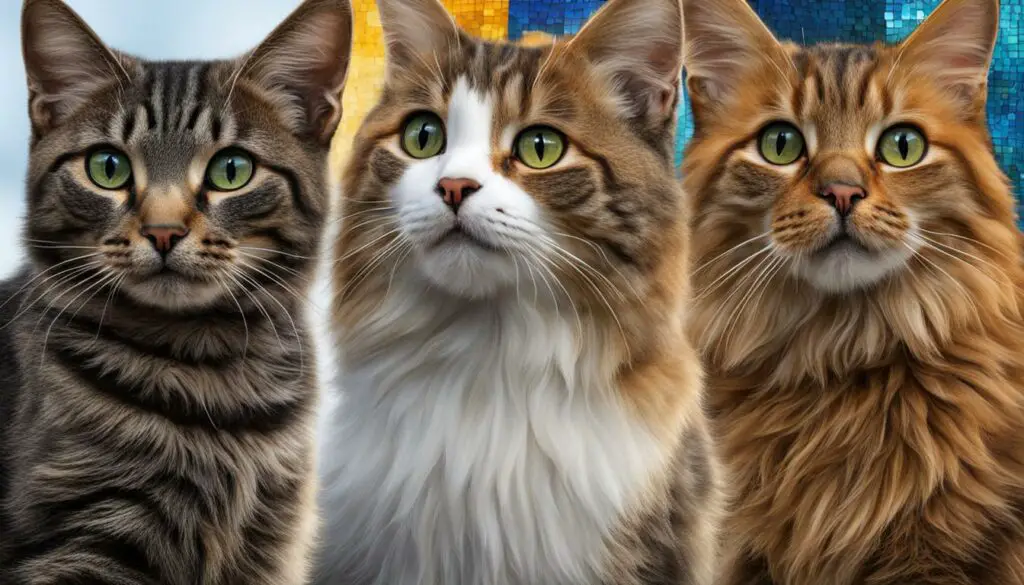
| Male Cats | Female Cats | |
|---|---|---|
| Size | Grow slower, larger | Grow faster, smaller |
| Weight | Heavier | Lighter |
| Maturity | Slower to mature | Quicker to mature |
| Behavior | Less prone to heat cycles | Experience heat cycles |
| Reproductive Maturity | Do not go into heat | Experience heat cycles |
Male cats tend to grow at a slower rate than females and often end up larger in size. Female cats reach puberty earlier and tend to be more fertile. Once male cats reach sexual maturity, they do not go into heat like female cats do. The size and weight of a cat can also vary based on breed and genetics.
Cat Adolescence and Behavior
During the adolescent stage, which typically lasts until around 18 months old, cats go through a period of increased energy and playfulness. This period is similar to the behavior of energetic kittens and is a normal part of their growth and development. As cats transition from kittens to adult cats, they gradually become more socially and behaviorally mature.
Adolescent cats may exhibit an abundance of curiosity and playfulness, often engaging in hunting-like behaviors with objects and toys. They may also become more adventurous and exploratory, testing their boundaries and venturing into new areas. This behavior is their way of learning about their environment and developing important skills for adulthood.
While their playfulness may be endearing, adolescent cats may also display occasional bursts of mischievousness or feistiness. It’s important to provide them with outlets for their energy, such as interactive toys and regular play sessions. Ensuring they have plenty of mental and physical stimulation will help prevent destructive behaviors and foster their overall well-being.

Adolescence and Socialization
Socializing adolescent cats is crucial for their long-term behavior and temperament. Exposing them to various people, animals, and environments during this stage helps them become well-adjusted adult cats. It’s important to provide positive experiences and gentle handling to build their trust and confidence in different situations.
“Adolescent cats may exhibit occasional bursts of mischievousness or feistiness. It’s important to provide them with outlets for their energy, such as interactive toys and regular play sessions.”
It’s also a good idea to continue training and reinforcing desired behaviors during adolescence. Reward-based training methods can help shape their behavior and teach them important skills, such as using a scratching post or coming when called. By setting clear boundaries and offering positive reinforcement, you can guide their behavior and encourage good habits.
The Importance of Patience
Dealing with the energetic behavior of adolescent cats requires patience and understanding. It’s important to remember that this stage is temporary and that their energy levels will eventually stabilize as they mature into adult cats. Providing them with a safe and stimulating environment, as well as offering plenty of mental and physical stimulation, can help channel their energy in positive ways.
By patiently guiding and shaping their behavior during adolescence, you can help your cat develop into a well-rounded and content adult companion. Understanding their unique needs during this stage will strengthen the bond between you and your feline friend and ensure a smooth transition into adulthood.
When Does a Cat Stop Being a Kitten?
Understanding when a cat stops being considered a kitten is essential for cat owners to provide appropriate care and support their development. On average, cats are officially no longer considered kittens once they reach one year of age. This is the point when they enter adulthood and begin displaying more mature behaviors. However, the transition from kitten to adult is a gradual process, and cats continue to grow and develop until they reach around 18 months old.
During the first year, kittens go through significant physical and mental changes, reaching various milestones. They start as tiny, vulnerable creatures and gradually develop into independent and self-sufficient beings. As they grow, their bodies and minds mature, allowing them to learn and adapt to their surroundings.
It’s important to note that individual cats may reach maturity at slightly different rates. Factors such as genetics, breed, and overall health can influence the pace of development. Some cats may take longer to fully mature, while others may reach adulthood earlier. If you have any concerns about your cat’s development or behavior, consulting with a veterinarian can provide valuable insights and guidance.
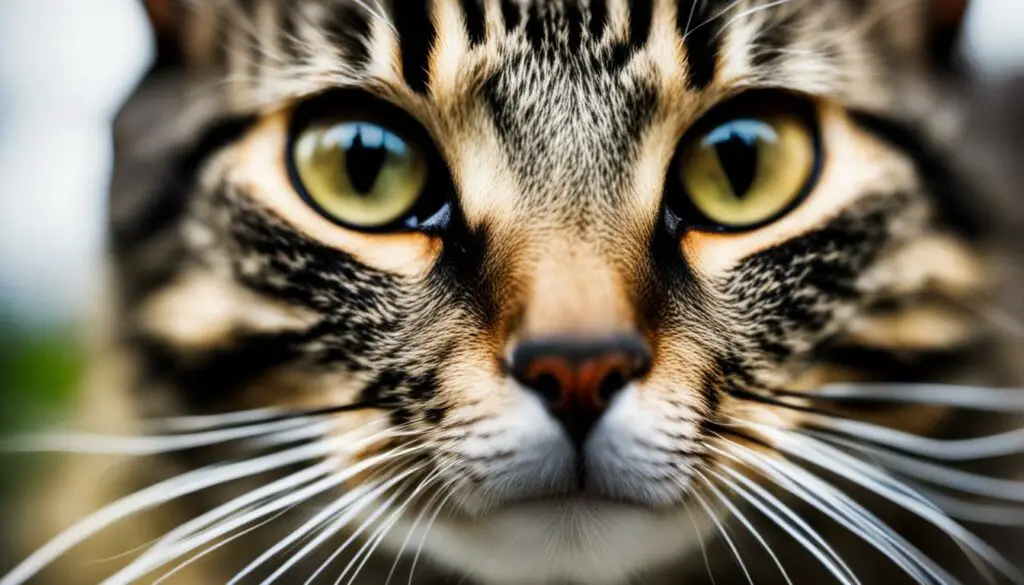
Cat Growth and Development
Cat growth and development encompass various aspects, including physical changes, behavioral shifts, and cognitive development. Understanding the different stages and milestones can help cat owners better care for their feline companions.
| Stage | Age Range | Description |
|---|---|---|
| Kitten Stage | Birth to 6-7 months | Period of rapid growth and development; crucial for socialization and litterbox training. |
| Junior Stage | 1-2 years | Reproductive maturity; focus on behavior, activities, and medical needs. |
| Adult or Prime Stage | 3-6 years | Temperament and personality are established; continued exercise, mental stimulation, and socialization are important. |
| Mature Stage | 7-10 years | Decreased activity levels; regular veterinary examinations become more crucial. |
| Senior Stage | 11-14 years | Further changes in activity levels and health; special considerations may be needed for mobility and sensory issues. |
| Geriatric Stage | 15 years and beyond | Increased medical needs; regular veterinary visits necessary to ensure comfort and quality of life. |
Throughout these stages, cats go through various physical and behavioral changes that contribute to their overall growth and development. By understanding these stages, cat owners can provide appropriate care and ensure their feline companions live healthy and fulfilling lives.
Conclusion
In conclusion, understanding the growth stages of a cat is essential for providing them with the care they need at each phase of their development. From the adorable and playful kitten stage to the more mature adult stage, cats undergo physical and behavioral changes that shape their unique personalities.
Once a cat reaches one year of age, they are officially considered adults and are no longer considered kittens. However, the transition from kitten to adult is a gradual process that continues until around 18 months old when cats are fully grown in size and weight.
Throughout their lives, cats require different levels of attention and care. This includes providing them with proper nutrition, socialization, exercise, and regular veterinary visits. By understanding the stages of cat growth and maturity, we can ensure our feline friends live happy and healthy lives.
So, whether you have a tiny ball of fur or a mature cat, each stage of a cat’s life is a unique and wonderful experience. By being mindful of their growth and developmental needs, we can foster a strong bond with our feline companions and provide them with the best possible care throughout their lives.
FAQ
When is a cat no longer considered a kitten?
Cats are generally no longer considered kittens once they reach one year of age.
What happens during the kitten stage?
During the kitten stage, which begins at birth and lasts until around 6-7 months old, a cat undergoes significant physical and mental changes. It is a critical period for their growth and development.
How long does the junior stage last?
The junior stage typically lasts from 1 to 2 years old. During this stage, cats become sexually mature and require proper behavioral and medical attention.
When does a cat enter the adult or prime stage?
Cats enter the adult or prime stage once they reach 3-6 years old. At this point, they have established their temperament and personality.
What happens in the mature stage?
The mature stage begins around 7-10 years old, and cats tend to be less active than adult cats. Regular veterinary exams become crucial to monitor their overall health.
What are the characteristics of the senior stage?
Cats in the senior stage, which occurs between 11-14 years old, may sleep more, eat less, and exhibit decreased activity levels. Regular veterinary visits become more important to monitor their health.
How should male and female cats be treated differently?
Male and female cats grow and mature at different rates. Male cats tend to grow slower and may end up larger in size. Female cats reach puberty earlier and tend to be more fertile.
What is cat adolescence like?
Cats go through an adolescence stage that usually lasts until around 18 months old. They may exhibit behaviors similar to energetic kittens, such as increased playfulness and curiosity.
When does a cat officially stop being a kitten?
Cats officially stop being considered kittens once they reach one year of age.

